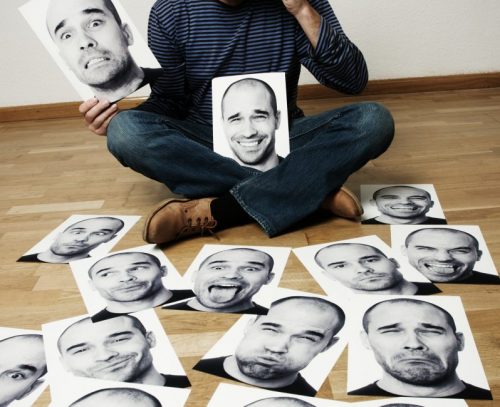The Inuit of Greenland traditionally paint their faces and pierce their cheeks to prepare for the Uaajeerneq, the Mask Dance. The elders dance to teach their youth how to prepare for the rigors of life, including how to deal with fear of failure.
Our 21st-century workplace needs its version of the mask dance.
Irrespective of industry, organizational rank, or personal temperament, fear of failure is the one conversation that professionals, including those in the C-Suite, resist the most, even behind the closed doors of a coaching conversation.
One of my group coaching clients said the mere act of talking about fear at work would make her look weak, so she keeps quiet. Her group nodded in agreement. We spent the next hour openly talking about failure and the fear of it.
Without these honest conversations, learning doesn’t happen and organizations are destined to repeat past mistakes, lose competitive ground and risk extinction.
In the business world, we wear a far less empowering mask; the work mask.
We don this work mask to appear confident and in control. However, similar to a child’s Halloween mask, our work mask reduces our peripheral vision, preventing us from seeing resources and opportunities in our environment that are the very keys to solving our big thorny problems.
This work mask weighs heavy.
We spend an inordinate amount of time, energy and cognitive bandwidth on maintaining our work mask, at a time when we need to be investing energy on learning, collaborating and innovating. Over time, we come to falsely identify with this mask, and we enter into a world where egos rule and self-protection is the object of the game. The casualty is our healthy self-esteem and a genuine sense of belonging.
What stops us from shedding our work masks and bringing our most authentic, creative and collaborative selves to our work?
We believe the myth that our work mask protects us from harm. Humans are inherently risk-averse, a requirement for survival.
Dr. Daniel Kahneman, winner of the Nobel Prize in Economics) and author of the seminal book, Thinking, Fast and Slow describes conducted an experiment that highlights how risk-averse we are. Study participants were asked if they would accept a bet based on the flip of a coin. If the coin landed heads up the participant would win $200.00, but if the coin landed tails, the participant would lose $100.00. In other words, it’s better not to lose $100 than to gain $200. In this experiment, the potential gain must be at least twice as much as the potential loss. According to Kahneman “Losses loom larger than gains.”
Risk-Averse Workplace Cultures
This fear of losing manifests as a risk-averse cultural within many organizations. Work teams and companies experience undue conflict borne out of the inherent tension between playing it safe and risk-taking.
In spite of our risk-aversion, companies must innovate if they are going to remain relevant in our turbulent, uncertain and complex world. The Boston Consulting Group recently reported that thirty-one % of professionals identified a risk-averse culture as a key obstacle to innovation.
According to Baba Shiv, professor of Marketing at Stanford Graduate School:
“Experimentation and failure are essential to innovation because, by its nature, innovation is an unknown that can only be discovered through trial and error. Failure is the mother of innovation”.
The entrepreneurial rally cry of “fail fast and fail often” understandably doesn’t sit well with the quarterly reporting-focused corporate mindset. Nonetheless, that doesn’t mean you can’t benefit from a healthier relationship with failure.
Here are three strategies for putting fear of failure into perspective:
1. Start talking about failure
Comparison, insecurity and vulnerability (which we believe could be taken advantage of) are why we don’t talk about our failures. Dr. Brene Brown, qualitative researcher and author, delves deeply into this topic in her book Rising Strong: The Reckoning, The Rumble and The Revolution. Brown writes:
“We gold-plate failure…skipping over it or sugar-coating the process and the pain involved in failing. Comparative suffering is a function of fear and scarcity. Falling down, screwing up, and facing hurt often lead to bouts of second-guessing our judgment, our self-trust, and even our worthiness”.
Shame is the final stop on this emotional cascade, which according to Brown is the “most powerful, master emotion. It’s the fear that we’re not good enough”.
With clients, I overtly signal that it is appropriate and safe to take on this heady subject. With my choice of words, tone of voice, and body language, I model that this conversation is welcomed and healthy. I say, “bring it on!”
The sense of relief that washes over my clients’ faces is a telltale sign that they have been holding onto this burden for far too long. When clients talk about what keeps them up at night they harness the power to transform their relationship with fear for the better. As professionals appreciate the valuable data behind their fear, they learn lessons about what drives them to succeed and what gets in their way. More importantly, they begin to identify a source of rich information about how they see the world, which is one of the first steps to making bigger moves in work and life.
Write your failure CV.
As a postdoctoral student at Caltech, psychologist Dr. Melanie Stefan wrote an article called “A CV of Failures” in one of the most prestigious scientific journals, Nature. The International Journal of Science. Publishing in this journal is a big feather in any scientist’s cap.
Stefan poignantly wrote:
“Societal pressures to manage our professional image often gets in the way of us being whole, fallible human beings. MyCV does not reflect the bulk of my academic efforts. It does not mention the exams I failed, my unsuccessful PhD or fellowship applications, or the papers never accepted for publication. At conferences, I talk about the one project that worked, not about the many that failed. As scientists, we construct a narrative of success that renders our setbacks invisible both to ourselves and to others. Often, other scientists’ careers seem to be a constant, streamlined series of triumphs. Therefore, whenever we experience an individual failure, we feel alone and dejected”.
Imagine what organizations would learn and how their teams would grow if leaders, particularly senior leaders, shared their biggest career mistakes?
2. Anticipate being wrong.
In his seminal book, Good To Great, Jim Collins writes about his teams speaking candidly as they worked together to discover the framework described in the book. He writes, “… we would debate, disagree, pound on tables, raise our voices, pause and reflect and debate some more…”.Had Collins believed he was right all the time, the framework that has been studied by countless organizations and business schools likely would never have emerged.
It’s incumbent upon twenty-first-century leaders to admit they don’t have all the answers. Hiring and cultivating a diverse team that sees the world differently than you is essential to developing the best ideas. Share an idea that might run counter to your team’s current line of thinking. Encourage your colleagues and direct reports to speak out if they have an idea that they might typically keep to themselves. A specific question you might consider according to researcher and author, Dr. Amy Edmonson is “Where am I wrong?”. Put another way, Dr. Jennifer Garvey-Berger, author and executive coach encourages leaders to ask their teams “What might I be missing here?”
Adopting a mindset of humility, brimming with curiosity is where 21-century leaders can stand-out.
3. Maximize learning after a failure
Ashley Good, Founder and CEO of Fail Forward, helps organizations get the maximal benefit from failure. Good uses her expertise as an engineer to help teams and organizations design healthy failure processes.
According to Good:
“At Fail Forward, we provide new perspectives on failure alongside the tools and skills to help us deal with missteps more productively – so that when we fail, we Fail Intelligently”. The mere act of documenting failure promotes the risk-taking, creativity and continuous learning required for innovation.”
When I interviewed Good she told me that there is no truth to the labels of “success” or “failure”; because every situation contains elements of both. When we can acknowledge that reality, we appreciate both where we have succeeded and learn from what didn’t go so well”.
Fear has value.
Good told me that fear has value as it makes us test our ideas. “What isn’t healthy is when fear paralyzes us. We need to acknowledge real risks and prepare for those risks appropriately. For example, imagine you sent an e-mail that you later regretted, or you bombed at an important presentation. These types of experiences help determine how they might impact your job, your career and the relationships that you hold dear”.
Replacing negative emotions with objective acceptance is the path through, Good told me. “It’s about separating yourself from the failure and acknowledging the role that you played in the situation. It means accepting responsibility”.
I still crisply recall a presentation I gave in Banff, Alberta twenty years ago. I fell significantly short of my expectations and I had a hard time shaking it off. Tentatively, I approached one of my mentors, who had attended the presentation and suggested that I work on public speaking skills. While painful to hear at the time, I sincerely took this advice to heart. Keynotes and workshops are now an essential and rewarding part of my work.
Step One
Good offers a simple, though not necessarily easy first step in developing resilience through failure. When facing a failure, she recommends pausing and breathing, to avoid a knee-jerk defensive reaction. The goal isn’t to deny or ignore the emotions that erupt after what feels like a failure; it’s ok to feel these emotions.
Step Two
As a second step, Good recommends setting your ego aside and developing a failure fascination mindset. Good reminds us that this new curiosity helps us learn and grow from our life experiences.
Ben Zander, Conductor of the Boston Philharmonic Orchestra, also highlights the need for mistake-fascination. Sitting on stage with Zander is a 15-year old Cellist who makes a mistake while playing a complicated piece of music. Zander invites the Cellist and the audience to throw their arms up into the arm and exclaim “How fascinating”, when we make a mistake to negate our typical ruminative reaction.
Both Good and Zander understand that being fascinated with our foibles helps open us up to possibilities so we can learn and become masterful.
Failure can be a powerful teacher or a harsh critic. Everyone gets to choose. Will you grow or will you wither? The opportunity to leverage your mistakes today is the key to your future success.



